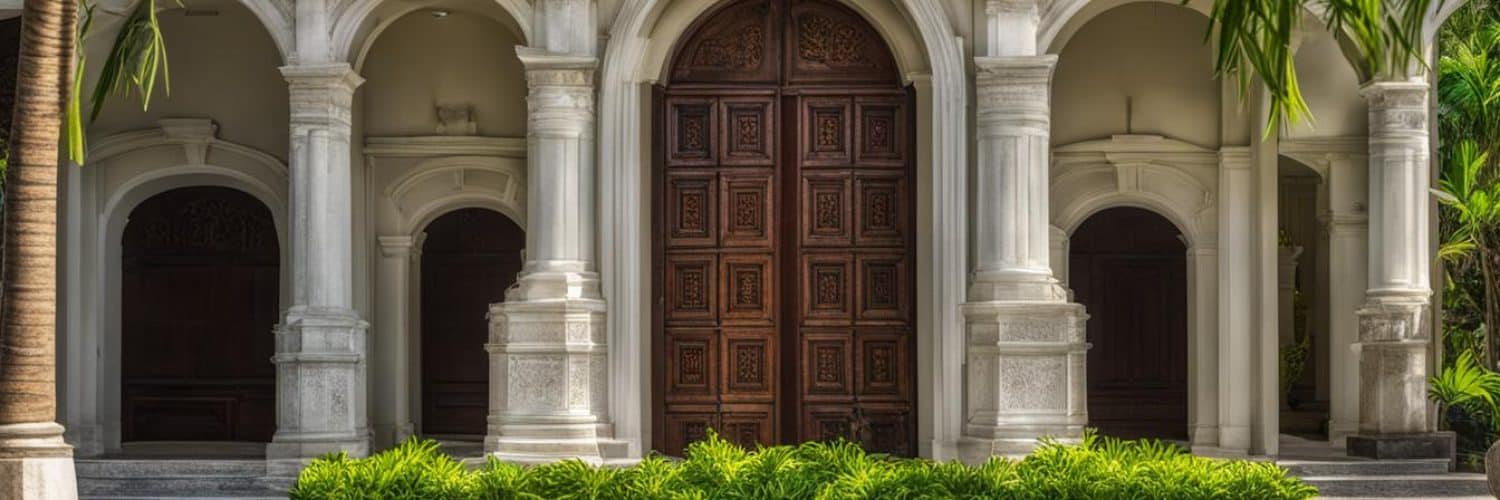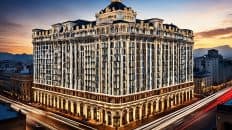Welcome to Museo Sugbo, the historical museum that takes you on a journey through the vibrant culture and rich heritage of Cebu, Philippines. As one of the premier heritage museums in the country, Museo Sugbo invites visitors to delve into the captivating history of Cebu, from pre-colonial times to the present day. With its well-curated exhibits and fascinating displays, Museo Sugbo offers an immersive experience that showcases the significant events and influences that have shaped the city’s identity.
Key Takeaways:
- Mueso Sugbo is a historical museum showcasing the vibrant culture and rich heritage of Cebu, Philippines.
- The museum offers well-curated exhibits that take visitors on a journey through the history of Cebu.
- Museo Sugbo stands as one of the premier heritage museums in the Philippines.
- The museum highlights the significant events and influences that have shaped Cebu’s identity.
- Museo Sugbo is a must-visit tourist attraction for those interested in Cebu’s culture and history.
The History and Heritage of Cebu
Cebu, with its rich culture and vibrant heritage, offers a fascinating glimpse into the past. At Museo Sugbo, the premier heritage museum in the Philippines, visitors can immerse themselves in the historical events, cultural traditions, and significant landmarks that have shaped this magnificent city. From the arrival of the Spanish colonizers to the preservation of Cebuano traditions and festivals, Museo Sugbo showcases the cultural significance of Cebu, making it a must-visit destination for those seeking to explore the city’s history.
Step into the museum and embark on a journey through time. The exhibits, filled with artifacts, artworks, and dioramas, meticulously depict the various aspects of Cebu’s history. Discover the early settlements that existed long before the Spanish era, learn about the city’s transformation under colonial rule, and witness the rise of Cebu as a thriving metropolis.
“Cebu has a rich and diverse history that spans centuries. It is a city of resilience, cultural pride, and profound heritage. At Museo Sugbo, we aim to showcase the significance of Cebu’s history and its enduring impact on Philippine culture.”
From the battles waged by local heroes to the unique blend of indigenous and foreign influences, Cebu’s history is a tapestry of stories waiting to be unraveled. The museum also sheds light on the cultural significance of Cebuano traditions, such as the Sinulog Festival, which celebrates the city’s conversion to Christianity. Through engaging exhibits and interactive displays, visitors can gain a deeper understanding of the vibrant cultural tapestry that is Cebu.
Explore Cebu’s Historical Sites
Beyond the walls of Museo Sugbo, Cebu is home to a plethora of historical sites. Embark on a journey to the majestic Magellan’s Cross, a symbol of the city’s conversion to Christianity, or visit Fort San Pedro, the oldest triangular bastion fortress in the Philippines. Don’t miss the iconic Basilica Minore del Santo Niño, which houses the image of the Santo Niño, one of the country’s most revered religious icons.
Experience the cultural heart of Cebu by strolling through the vibrant streets of Colon, one of the oldest and busiest avenues in the city, or wander through the quaint neighborhoods of Carcar and Argao, where Spanish and indigenous influences converge. Immerse yourself in the rich history and architectural wonders that have made Cebu a captivating destination.
Cebu’s history and heritage are a testament to the resilience and ingenuity of its people. Museo Sugbo, along with the city’s historical sites, offers a glimpse into the captivating past that has shaped this vibrant city. Whether you are a history enthusiast or simply seeking a deeper understanding of Cebu’s cultural significance, Museo Sugbo is an essential destination that celebrates the rich tapestry of Cebuano history and culture.
The Exhibits at Museo Sugbo
Museo Sugbo features a wide range of exhibits that showcase Cebu’s history, culture, and heritage. The museum houses a fascinating collection of Cebuano artifacts, including ceramics, clothing materials, and cooking apparati, providing valuable insights into the daily life and traditions of the Cebuanos in different historical periods.
The museum’s exhibits go beyond static displays and incorporate historical dioramas, which offer vivid depictions of important events and significant moments in Cebu’s history. Through these visual representations, visitors can immerse themselves in the captivating stories of Cebu’s past.
In addition to the Cebuano artifacts and historical dioramas, Museo Sugbo also highlights the trade history of Cebu, showcasing the significant role of the Chinese community in the development of the city as a bustling trading hub. Explore the cultural displays that illustrate the interplay between different cultures and the thriving economic exchanges that shaped Cebu’s trade history.
With its diverse and informative exhibits, Museo Sugbo offers a comprehensive experience that deepens understanding of Cebu’s rich heritage and cultural tapestry. Visitors can engage with the displays, gain valuable knowledge, and appreciate the intricate interconnectedness of history, culture, and trade in Cebu.
Cebuano Artifacts: A Glimpse into the Past
Step back in time as you explore the numerous Cebuano artifacts on display at Museo Sugbo. These artifacts provide valuable insights into the daily lives, customs, and craftsmanship of the Cebuanos throughout history. From intricately designed ceramics to intricately woven textiles, these artifacts paint a vivid picture of Cebuano culture and the skills passed down through generations.
Historical Dioramas: Bringing History to Life
Immerse yourself in Cebu’s past through the museum’s historical dioramas. These meticulously crafted miniature scenes recreate significant events and moments, allowing visitors to visualize the dynamic history of the region. From the arrival of the Spanish colonizers to pivotal battles and cultural celebrations, the dioramas offer a captivating glimpse into Cebu’s rich historical narrative.
Cultural Displays: Tracing Cebu’s Trade History
Discover the vibrant tapestry of cultures that have influenced Cebu’s trade history at Museo Sugbo. The museum’s cultural displays highlight the significant role of the Chinese community in shaping Cebu as a thriving trading center. Explore the artifacts, stories, and historical connections that exemplify the cosmopolitan nature of Cebu’s trade networks and the fusion of cultures that define the city.
The Sugbu Chinese Heritage Museum
Adjacent to Museo Sugbo is the Sugbu Chinese Heritage Museum, a fascinating homage to the Chinese community’s history and contributions in Cebu. This unique museum is the first of its kind in the Philippines, dedicated to showcasing the influential presence of the Chinese immigrants specifically in Cebu. Through a wide range of exhibits, including antiques, dioramas, and artworks, the museum highlights crucial historical moments and explores the intricate relationships between the Cebuanos and the Chinese immigrants.
The Sugbu Chinese Heritage Museum offers insightful glimpses into how Chinese culture, trade, and development have shaped and influenced Cebu. Visitors can delve into the vibrant history and discover the remarkable impact of the Chinese community in various aspects of Cebu’s heritage. From their significant contributions to trade and commerce to their rich cultural traditions, the museum’s highlights celebrate the dynamic synergy between the Chinese immigrants and the local community.
Historical Significance of the Gotiaoco Building
The Gotiaoco Building in Cebu holds immense historical significance, serving as a testament to the Chinese Filipino history and Cebu’s vibrant business pioneers. Established by Chinese migrant Manuel Gotianuy, this iconic landmark played a pivotal role in the city’s business and commerce. The building is named after Manuel’s father, Don Pedro Gotiaoco, who was one of the wealthiest men in Cebu during that time.
The Gotiaoco Building, which houses the Sugbu Chinese Heritage Museum, stands as a symbol of the prosperous Chinese community in Cebu and their contributions to the city’s development. This century-old structure holds a special place in Cebu’s history as it was the first building to be equipped with air conditioning and an elevator, representing a leap forward in architectural advancements. The Gotiaoco Building has become a Cebu landmark, embodying the fascinating blend of Chinese and Filipino cultures.
With its grand presence and historical significance, the Gotiaoco Building stands as a tribute to the Chinese Filipino pioneers who played an integral role in shaping the economic landscape of Cebu. It serves as a reminder of the rich heritage and entrepreneurial spirit that continues to thrive in the city.
“The Gotiaoco Building stands as a testament to the fusion of Chinese Filipino history and Cebu’s vibrant business pioneers. Its architectural marvel and historical significance make it a must-visit landmark for those seeking to delve into the unique cultural tapestry of the city.”
Architectural Highlights of the Gotiaoco Building
The Gotiaoco Building’s architectural features are a testament to the visionary ingenuity of its time. Here are some notable highlights:
| Architectural Feature | Description |
|---|---|
| First Building with Air Conditioning in Cebu | The Gotiaoco Building was the pioneering architectural marvel to introduce air conditioning technology in Cebu, marking a significant leap forward in comfort and innovation. |
| First Building with an Elevator in Cebu | Another groundbreaking feature was the installation of an elevator, revolutionizing vertical transportation in Cebu and setting a new standard for modern architectural design. |
| Distinctive Colonial Style | The building showcases a captivating colonial-style architecture that seamlessly integrates Chinese and Filipino influences, reflecting the fusion of cultures that define the city’s heritage. |
| Elegant Façade and Ornate Details | The Gotiaoco Building boasts an elegant façade adorned with intricate details, exemplifying the grandeur and opulence of its era. |
The architectural marvel of the Gotiaoco Building continues to captivate both locals and tourists, drawing admiration for its historical significance and remarkable design.
The Transformation of the Gotiaoco Building
The Gotiaoco Building, now home to the Sugbu Chinese Heritage Museum, underwent a remarkable transformation through a meticulous renovation process. Starting in 2016, under the guidance of Bob Gothong, the current president of the museum, the restoration project aimed to turn the building into a cultural landmark.
The renovation of the Gotiaoco Building was made possible with the generous support of the Cebu City government, recognizing its historical significance and importance as a venue for the heritage museum. The government’s backing not only provided the necessary funding but also highlighted their commitment to the preservation of Chinese heritage in Cebu City.
The management of the Sugbu Chinese Heritage Museum has been actively involved in ongoing research and fundraising efforts to enhance the exhibits and ensure the proper preservation of Chinese heritage. By continuously exploring new avenues for improvement, the museum’s management team strives to create an immersive and educational experience for visitors, highlighting the rich cultural tapestry that shaped Cebu’s history.
| Gotiaoco Building Transformation Highlights |
|---|
| Meticulous renovation process |
| Cebu City government support |
| Fundraising efforts for exhibit improvement |
| Preservation of Chinese heritage |
The renovation of the Gotiaoco Building and the establishment of the Sugbu Chinese Heritage Museum symbolize the collaborative efforts made by all involved to bring history to life. The successful transformation of the building ensures that future generations can explore and appreciate the significant role of Chinese heritage in Cebu’s cultural fabric.
Exploring Cebu’s Trade and Commerce
Museo Sugbo offers a fascinating glimpse into the trade and commerce history of Cebu. Through its diverse exhibits, visitors can delve into the Cebuano business history, the products that were traded and bartered during different historical periods, and the trade routes that connected Cebu to other parts of the Philippines and beyond.
The museum showcases the entrepreneurial spirit of the Cebuanos, highlighting the significant role they played in the development of trade and commerce in the region. From the early pioneering days to modern entrepreneurship, Museo Sugbo pays homage to the business pioneers who shaped Cebu’s vibrant commercial landscape.
“Cebuano entrepreneurs have always been at the forefront of the region’s economic growth. Their determination, innovation, and adaptability have been instrumental in establishing Cebu as a hub for trade and commerce.” – Bob Gothong, President of Museo Sugbo
One of the highlights of the museum is the depiction of Cebu trade routes, showcasing the connections that allowed the exchange of goods and ideas. These trade routes not only facilitated commerce but also served as conduits for cultural exchanges, influencing the development of Cebuano art, architecture, and traditions.
Visitors can also learn about the Cebuano products that were highly sought after during various time periods, ranging from fine textiles and handicrafts to agricultural products and marine resources. These products not only contributed to the region’s economy but also played a role in shaping its cultural identity.
The Impact of Cebuano Entrepreneurship
Cebuano entrepreneurship has played a vital role in driving economic growth and development, not only in Cebu but also in the wider Philippines. The entrepreneurial spirit of the Cebuanos can be traced back centuries, with notable individuals and business families making significant contributions to the region’s prosperity.
- The Aboitiz Family: The Aboitiz family, originally from Spain, established their business in Cebu during the late 1800s. Their ventures in shipping, power generation, and other industries have been instrumental in Cebu’s economic progress.
- The Gaisano Family: The Gaisano family is known for its retail business empire, which started with a small store in Cebu City. Their entrepreneurial success paved the way for the growth of the retail industry in the region.
- The Osmeña Family: The Osmeña family has long been associated with Cebu politics and entrepreneurship. Sergio Osmeña Sr., a former Philippine president, made significant contributions to Cebu’s development, particularly in the fields of healthcare and education.
Cebuano entrepreneurship continues to thrive today, with a new generation of innovative and resilient business leaders driving the region’s economy forward. Museo Sugbo celebrates their achievements and encourages aspiring entrepreneurs to learn from the rich history of Cebuano business.
As visitors explore Museo Sugbo’s trade and commerce exhibits, they gain a deeper appreciation for Cebu’s economic heritage. The museum’s immersive displays and interactive features provide a captivating journey through Cebu’s bustling commercial past, inspiring visitors to reflect on the entrepreneurial spirit that continues to shape the region’s future.
Museo Sugbo as a Tourist Attraction
Museo Sugbo, located in Cebu City, is a prominent tourist attraction that offers a captivating journey into the rich history and culture of Cebu and the Philippines. This museum is a must-visit for travelers looking to immerse themselves in the local heritage and learn about the fascinating past of the city.
As one of the top museums in Cebu, Museo Sugbo stands alongside other cultural landmarks, making it an essential part of any itinerary for those exploring the city. The museum provides educational and immersive experiences that allow visitors to delve deeper into the historical and cultural significance of Cebu.
At Museo Sugbo, you can expect to find a diverse range of exhibits that showcase the remarkable artifacts, artworks, and dioramas depicting various periods in Cebu’s history. Through these exhibits, you can gain a deeper understanding of the vibrant cultural heritage that makes Cebu truly unique.
The Cultural Landmarks of Cebu
- Magellan’s Cross: A symbol of Cebu’s connection to its colonial past and the arrival of Christianity in the Philippines.
- Fort San Pedro: The oldest triangular bastion fort in the country, offering a glimpse into Cebu’s military history.
- Basilica Minore del Santo Niño: A religious landmark housing the revered Santo Niño de Cebu, a statue brought by the Spanish explorers in the 16th century.
- Taoist Temple: A serene oasis where visitors can explore Taoist teachings and enjoy stunning views of Cebu City.
- Lapu-Lapu Shrine: A tribute to the bravery and heroism of the Filipino chieftain Lapu-Lapu, who fought against the Spanish colonizers.
Cebu’s vibrant travel scene is enriched by the presence of Museo Sugbo, which provides a glimpse into the city’s captivating past. With its historical and cultural significance, the museum is a valuable addition to Cebu’s attractions, offering a memorable experience for both locals and tourists alike.
Conclusion
Museo Sugbo is a testament to the rich culture and heritage of Cebu, making it one of the must-visit destinations for tourists seeking to learn more about the vibrant cultural heritage of the Philippines. The museum, along with the Sugbu Chinese Heritage Museum, provides an immersive experience that allows visitors to explore the city’s history, including the Chinese influence, trade history, and significant landmarks in Cebu. It serves as a crucial hub for heritage preservation in Cebu, showcasing the diverse facets of Cebuano culture and history.
With its well-curated exhibits and informative displays, Museo Sugbo offers a comprehensive insight into the historical and cultural significance of Cebu. The museum’s contribution to the preservation of the city’s heritage is invaluable, highlighting the importance of safeguarding Cebu’s historical sites for future generations. As one of the premier historical museums in Cebu, Museo Sugbo continues to attract visitors from all around the world, cementing its position as a top Cebu tourist attraction.
By exploring Museo Sugbo, visitors gain a deeper understanding of Cebu’s past and the role it played in shaping the country’s history. The museum is a treasure trove of artifacts, dioramas, and exhibits that depict the richness of Cebuano traditions, Cebu culture, and its historical significance. Whether you are a history enthusiast or simply curious about Cebu’s heritage, a visit to Museo Sugbo will be a rewarding experience that brings the past to life. Discover the fascinating stories of Cebu’s past and immerse yourself in the diverse cultural tapestry that defines this beautiful city.
FAQ
Is Museo Sugbo a historical museum?
Yes, Museo Sugbo is a historical museum that showcases the vibrant Cebuano culture and heritage.
What can I expect to see at Museo Sugbo?
At Museo Sugbo, you can expect to see exhibits that offer a fascinating journey through the rich history of Cebu. The museum showcases Cebuano artifacts, historical dioramas, and highlights the trade history of the region.
Is there a museum dedicated to the Chinese community in Cebu?
Yes, adjacent to Museo Sugbo is the Sugbu Chinese Heritage Museum, which focuses on the Chinese community’s history and contributions to Cebu. It is the first museum in the Philippines dedicated to highlighting the Chinese presence in Cebu.
What is the historical significance of the Gotiaoco Building?
Has the Gotiaoco Building undergone any renovations?
Yes, the Gotiaoco Building went through a renovation process to transform it into a cultural landmark. The restoration project began in 2016 and was supported by the Cebu City government.
What does Museo Sugbo showcase in terms of Cebu’s trade and commerce history?
Museo Sugbo showcases the Cebuano business pioneers, the products that were traded during different historical periods, and the trade routes that connected Cebu to other parts of the Philippines and beyond.
Is Museo Sugbo a popular tourist attraction?
Yes, Museo Sugbo is a popular tourist attraction in Cebu City. It offers visitors a unique opportunity to explore the rich history and culture of Cebu and the Philippines.
What is the significance of Museo Sugbo in Cebu’s heritage preservation?
Museo Sugbo plays a vital role in heritage preservation in Cebu. It showcases the rich cultural heritage of the region and offers educational experiences for locals and tourists alike.
Can Museo Sugbo provide insights into Cebu’s cultural landmarks?
Yes, Museo Sugbo, along with the Sugbu Chinese Heritage Museum, provides insights into the significant cultural landmarks in Cebu, both from the Cebuano and Chinese perspectives.











Add comment